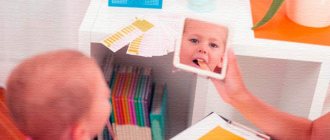Children with SSD (severe speech impairment) are a separate category of children with normal development of the hearing system and with unimpaired basic intelligence, but with significant speech deviations. Such defects can have a negative impact on the psyche. Speech therapy determines that this deviation leads to the child’s inability to master the school curriculum.
Some of these children have difficulty speaking. They have a very limited vocabulary. There are severe cases when a child cannot put together a pair of words at all. It may seem that this is directly related to reduced intellectual development, but the problem lies in the lag in mental development. In the future, this will manifest itself in difficulties with arithmetic and literacy.
In the extreme form of TNR, lexical and grammatical underdevelopment and difficulties with coherent speech can be traced. This results in inhibited thinking, difficulties in reading and writing.
Expert opinion
Margarita Sergeevna S.
Speech pathologist and speech pathologist with 15 years of experience working in various speech correction centers with children of different ages.
The main problems with TNR are stuttering, alalia, and aphasia.
Classification of severe speech disorders
Speech therapists currently identify two classification options for speech development difficulties in preschool children. Based on the pathologies, the following clinical picture was formed:
- problem with pronunciation of sounds (stuttering, dysarthria);
- problem with speech timbre (bradylalia, tachylalia);
- voice problem (aphonia, dysphonia);
- problem with reading and writing.
Based on the diagnosis, specialists determine individual treatment methods for each child.
In the Russian Federation, another classification of speech defects in children has been created. It is called psychological-pedagogical:
- general, phonetic and phonemic difficulties with speech development;
- stuttering.
For a complete and correct diagnosis, speech disorders in both classifications should be considered. In this case, you will be able to choose the right course of treatment.
Do you notice a speech disorder in your child?
Not really
sounds [P], [P']
To set the sounds [P], [P'], a set of exercises is used - “Spatula”, “Cup”, “Painter”, “Let’s brush our teeth”, “Woodpecker”, “Accordion”, “Turkey Poults”, “Drummer”.
Such exercises perfectly develop articulation, stretch the frenulum, and strengthen the facial muscles. But to make the sound [P], they also use special exercises:
1. The child should open his mouth, press the tip of his tongue to the base of the front teeth near the roof of the mouth, while asking him to quickly pronounce the sound “d-d-d.” After a few seconds, ask the child to blow strongly on the tip of the tongue, without stopping to pronounce the sound “d”. This exercise will help the child feel the desired vibration and remember it.
2. The child opens his mouth wide and pronounces the sound “zh-zh-zh”, moving the tongue closer to the growth line of the upper teeth. After a couple of seconds, insert a special spatula under the child’s tongue and move it rhythmically to the sides, creating vibration. In this case, the child must blow forcefully on the pronounced sound, feeling the vibration and vibrations that result.
3. Ask the child to make the sound “z-z-za”, pushing the tongue back as far as possible. Similar to the second exercise, insert the spatula under your tongue and move it left and right. If you do the training correctly, you will eventually hear a clear “R” sound.
4. Similar to exercise No. 3, ask the baby to pronounce the sounds “z-zi” without closing his mouth. Make similar movements with a spatula. This exercise will allow you to make the sound “r”, but softer.
If the child cannot keep his tongue up, and the sound itself turns out to be dull, ask him to lengthen the sound - drn-drn (for example, start the car).
sound "SH"
To put the child’s articulatory organs in the correct position in which he can pronounce the sound “Sh”, you can use a mechanical technique. To do this, we ask the child to pronounce the long sound “C” or the syllable “SA”. At this time, you need to carefully lift the tip of the tongue by the upper row of teeth onto the alveoli using a spatula or spoon. Thanks to such manipulations, the child will be able to pronounce the sound “SH”. But it’s too early to end this exercise: it is important to draw the child’s attention to his pronunciation of this sound. The adult’s task is to help the child understand and remember this position of the articulatory organs.
To form the sound “Ш” the following techniques are used:
1. Imitation performance. Ask your child to lift his tongue towards his upper lip, forcefully but evenly, and let him exhale, controlling the flow of air with the back of his hand. As soon as warm air is felt, offer to move the tongue behind the upper teeth, touching the palate. The mouth should be slightly open, the lips should be slightly extended, the teeth should be a couple of millimeters apart. Invite your baby to exhale a stream of air - you will get the sound “SH”.
2. Setting the sound “T” to the base. Ask your baby to pronounce the sound “T” every 2 seconds. Then ask him to make his tongue hit the alveoli rather than the teeth. Gradually, the sonorous “T” will turn into a more hissing sound. Next, ask the child to round his lips and pull them forward, and lift his tongue up towards the palate (towards the front). The sides of the tongue should be pressed against the molars. Now, pronouncing the sound “T”, the child will be able to smoothly move on to pronouncing the sound “SH”.
3. Based on the sound "S". Offer to move the tongue behind the lower teeth and pronounce the sound “C”. At the same time, use a spatula to lift the tongue up, let the child continue to pronounce the sound “C”. Using your fingers, lightly press on the cheeks so that the lips move forward. You should hear a hissing sound. To consolidate the result, ask the child to pronounce the syllables “SA”, “SI”, “SO”, “SY”, “SU”, “AS”, etc.
sound "Zh"
The sound “Zh” is placed by analogy with the sound “Sh”. The only difference is that in this case we add voice sound. Articulation during production should be as follows:
· the lips are rounded and slightly moved forward;
· teeth are close together, but not closed;
· the wide tip of the tongue is brought closer to the upper palate or alveoli, forming a gap between them; lower the middle of the tongue, pressing its edges to the side teeth; lift the back of the tongue and pull it back;
· a warm stream of air should pass through the middle of the tongue, which can be felt with the palm of your hand;
· the soft palate is lifted, pressing it to the pharynx, to its back wall, closing the passage into the nasopharynx, a stream of air exits through the mouth;
· The vocal folds need to be tensed and a voice must be produced.
As exercises, you can use imitation games (“Say what a bee says,” “...how a plane flies,” “...how a beetle buzzes,” etc.), tongue twisters, identifying sounds in words, and others.
sound "Ch"
When pronouncing the sound “Ch,” the child is asked to slightly round his lips, making a tube, and move them a little forward. There is no need to close your teeth, but they should be close to each other. The back and tip of the tongue should connect to the alveoli or upper teeth, forming a gap. When trying to pronounce the sound “Ch”, the child should feel a short stream of air passing through the middle of the tongue. The soft palate remains raised and pressed to the back of the pharynx. The vocal cords should not strain.
The sound “Ch” is made on the basis of “Ть” and “Ш”.
Pronounce the sound “TH” often and quickly (the tip of the tongue should touch the base of the upper teeth). Then the baby should gradually move his tongue back, touching the upper alveoli with it. In the process, the lips should stretch into a smile.
1. Ask the child, first slowly and then quickly, to pronounce the sounds “TH” and “SH”, so that in the end it comes out TSH. Follow
Reasons for the development of pathology
Very often it is difficult to establish the cause of a deviation based on one of the signs, since the problem consists of a number of factors. Experts identify the following main causes of TNR: :
- damage to the child’s head during childbirth or in the first years of life;
- health problems during pregnancy. Various infectious diseases of the expectant mother;
- fetal hypoxia;
- bad atmosphere in the family. Rude attitude towards a child;
- excessive strictness in education;
- common diseases in children (rickets, cerebral palsy, Down syndrome, asthenia).
A child may not develop his speech well if he has deaf parents. The most dangerous periods for disruption of speech development are 1-2 years and 5-6 years.
Important: in some cases, impaired speech development may be due to viral and bacterial infections.
sound [Ts]
Articulation:
· lips are in a neutral position;
· teeth are brought closer by 1-2 mm;
· the tip of the tongue is lowered, touching the lower incisors; Initially, the back of the tongue is strongly curved, forming a bow with the incisors, then its front part quickly moves to the position of the “C” sound, forming a groove in the middle;
· the air stream should be strong and uneven.
The sound “C” is produced if the child clearly pronounces the sounds “S” and “T”. The child is asked to quickly pronounce “TS”, as a result of which the desired sound appears.
There are 3 ways to make the sound “C”:
1. Method of imitation, using play techniques (“The locomotive, stopping, says - shh-tsk-tsk”, “The mouse is sleeping, don’t make noise - tss-tsk-tsk!”).
2. Reception of reference sounds (in this case these are “T” and “S”).
3. Acceptance of the features of the articulatory structure. Invite the child to open his mouth, rest the tip of his tongue against the incisors of the lower row of teeth, lift the tongue and stretch it so that its front part is pressed against the palate. In this position, the back of the tongue should touch the upper incisors. Without turning on your voice, invite your baby to pronounce the sound “T”, lifting the tip of the tongue with the pressure of a stream of air from the front teeth of the lower row. The lips should be tense and in a smiling position. This exercise helps to remember the position of the organs of articulation when the sound “C” is pronounced.
Education of children with SLD in kindergartens
Children diagnosed with SLD are able to study in specialized preschool institutions or in regular kindergartens, where a speech therapist works. Such an institution is obliged to develop an AOEP (adapted basic general education program) for children with special needs in preschool educational institutions. Such a program is created individually in
every kindergarten.
In such a development, aspects of the psychophysical and speech development of each individual child should be considered. It takes into account the child’s capabilities, a plan for his correction and adaptation in the social sphere. This means that the kindergarten applies the state program for children with SLD, but at the same time makes adjustments taking into account the personality characteristics of each child. Approval of such a document is carried out by the manager and the management council.
Each preschool institution can operate several such directives at once. Mandatory items must be:
- system for assessing children's successes and achievements;
- a list of items and actions to achieve your goals;
- developed extracurricular development program;
- expected results and results of the work performed.
Important: it is advisable to send children with SLD to a preschool institution where similar children have previously studied. Educators and teachers already have considerable experience in communicating with such children. It will be much easier for them to find a common language with the child.
It will also be useful for such children to be in society with ordinary children. They will be able to learn a lot and will not feel isolated from society.
Don't miss: What is SSD (speech development delay)?
sound [З]
The articulation when producing the sound “Z” is similar to “S”, only the sound “Z” is more sonorous, so you need to use your voice when pronouncing it. The sound “Z” is placed after successful automation of “S”.
Setting “Z” is similar to working with the sound “S”, only you need to make sure that the child connects his voice and feels the vibration of the ligaments. It is very important to be able to convey to the child that these sounds differ in their sound. To do this, invite the child to place a pen on his throat and pronounce both sounds alternately. The child will understand this difference by vibration. When the sound “Z” is heard clearly, invite the child to pronounce it louder and clearer. After this, automate the sound through exercises on pronouncing syllables, words, and sentences.
Problems in teaching children with SLI in schools
With this diagnosis, students tend to slow down the perception of information. Their performance is at a reduced level. Associative connections between auditory, visual and speech abilities are disrupted. There are difficulties in organizing voluntary activities. Also, when deciphering the diagnosis of TNR, memory deterioration and deviations in spatial orientation are manifested. Students have poor self-control. Impairments in fine motor skills, visual and auditory coordination are noticeable.
Expert opinion
Margarita Sergeevna S.
Speech pathologist and speech pathologist with 15 years of experience working in various speech correction centers with children of different ages.
Due to problems with speech, difficulties in understanding and mastering material in the Russian language appear. As a result, difficulties arise with writing.
If a child is unable to master educational material, his motivation to overcome obstacles decreases. Children with SLD have decreased self-esteem and decreased desire for further education. All this leads to an inability to adapt to the school environment.
If qualified speech therapy and medical and psychological assistance are not provided, children will not be able to receive quality education.
sounds [K], [G], [X]
The sound “K” is made mechanically using a spatula. The articulation looks like this:
· lips should take the position of the next vowel sound;
· You can’t keep your teeth closed;
· the tip of the tongue should be lowered and touched with the incisors of the lower dentition;
· the lateral parts of the tongue are adjacent to the upper lateral teeth;
· the back of the tongue should form a bow with the palate;
· the soft palate rises at this time, blocking the passage to the nasopharynx;
· there is no need to strain the vocal cords, they are open;
· during exhalation, the resulting stream of air should explode the bow, causing a characteristic sound.
The first version of the production is from the sound “T”. It is used if the child pronounces the sound “T” clearly, cleanly, without unnecessary overtones.
Invite your child to play the sound "TA". At the same time, press the spatula on the front part of the back of the tongue, as a result of which the sound “TY” will be heard. Next, you need to move the spatula a little further into the depth, which will provoke the pronunciation of the sound “KY”. Even deeper pressure on the tongue gives a clear pronunciation of the sound “KA”. The use of the mechanical method is stopped when the child remembers the location of the articulatory organs for pronunciation of the sound being studied.
The sound “K” can be made while inhaling. This exercise is reminiscent of imitation snoring - silent or whispering. Encourage your child to snore for fun. After the exercise, you can hear a sound reminiscent of “K”. Invite your child to say “KA” while inhaling and exhaling. After this, automate the sound traditionally: “KA-KO-KU-KI-KE-KYO.”
The articulation of the sound “G” is similar to the articulation of the sound “K”. However, the voice is involved in this process - the vocal cords must close and vibrate during exercise.
The sound "G" can be placed from "Y". To do this, invite the child to throw his head back and, while exhaling strongly, say “YYYYY”, simultaneously pushing his lower jaw forward, raising it and lowering it. By analogy with the production of the sound “K” from “TA”, you can place the sound “G” from “DA”.
The articulation of the sound “X” differs from “K” in that the back of the back of the tongue should form not a bow with the palate, but a gap along the midline. The sound “X” can be made like this: invite the child to open his mouth the width of two fingers and blow warm air on his palms. If the sound does not work, you can try throwing your head up in the process. The sound “X” can be placed from “S” and “Sh”. They use a mechanical method: when the child pronounces these sounds, you need to use a spatula to move the tongue deeper into the mouth.
Technology and methods of teaching students
Along with general requirements, schools are faced with more in-depth tasks to help children with speech disorders. Among them:
- correction of oral and written speech;
- in the process of eliminating defects, take into account the mental development of each child;
- professional training.
The educational process involves the allocation of significant time devoted to the work activities of schoolchildren. Thanks to this approach, several problems are solved simultaneously. First of all, the adaptation of children with disabilities to society, the formation of personality and preparation for life outside of school. This aspect also includes the physical development of children with SLD.
Education of children with special needs
This category includes children with disorders:
- hearing;
- vision;
- speeches;
- musculoskeletal system.
The teaching methodology includes:
- identification of various developmental pathologies;
- after the diagnosis is made, immediately provide psychological and pedagogical support;
- create a special rehabilitation program;
- identify developmental features and create a self-education plan;
- involve the child’s family and environment in the recovery process;
Expert opinion
Margarita Sergeevna S.
Speech pathologist and speech pathologist with 15 years of experience working in various speech correction centers with children of different ages.
Education of children with special needs is carried out in special schools and boarding schools.
Technology of compensatory education
Statistics indicate that more than 20% of children have various delays. If you do not start eliminating defects in time, the child will lose adaptation in the educational process.
The following sensory systems act as compensatory functions in children with SLI:
- tactile sensations;
- hearing (provided there are no impairments);
- vision (if no problems are identified);
- motor function.
Success in eliminating speech defects directly depends on the state of the listed systems and the ability to use them.
Equally important for children with SLD is pedagogical work aimed at:
- voluntary training;
- adapted content of educational material;
- additional classes;
- involvement of the child’s compensatory capabilities in the learning process;
- the pace of delivery of material depending on the speed of assimilation.
The main elements of successful rehabilitation are considered to be a loyal and understanding attitude towards students.
sound [Y]
Most often, the sound “Y” can be produced by imitation, supplementing the exercises with showing correct articulation and the tactile sensation of the expiratory stream when pronouncing “YYYY” in a drawn-out manner.
They make a sound from pronouncing the sounds “AIA” or “IA”. The exhalation must be intensified when the sound “I” is pronounced, and the short “A” must be pronounced without interruption. Sometimes placing the “Y” sound in words where it comes first is effective.
From the syllable “ЗЯ” the sound is made mechanically: the child pronounces the syllable, and the adult, using a spatula, presses on the front part of the back of the tongue, gradually moving it back until the desired sound is obtained.








